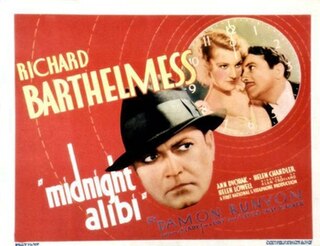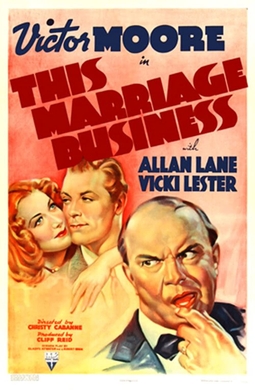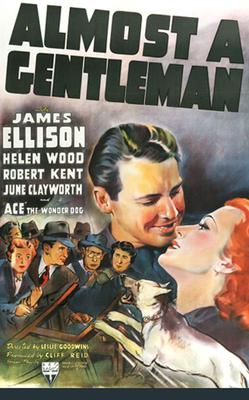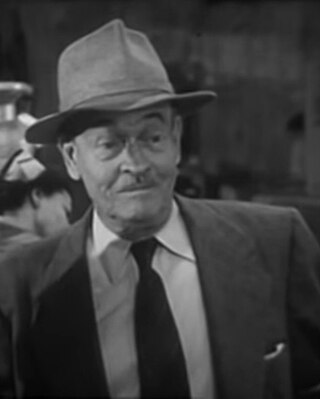Related Research Articles
Harry Segall was an American playwright, screenwriter and television writer.

Laurence Norwood Trimble was an American silent film director, writer and actor. Trimble began his film career directing Jean, the Vitagraph Dog, the first canine to have a leading role in motion pictures. He made his acting debut in the 1910 silent Saved by the Flag, directed scores of films for Vitagraph and other studios, and became head of production for Florence Turner's independent film company in England (1913–1916). Trimble was most widely known for his four films starring Strongheart, a German Shepherd dog he discovered and trained that became the first major canine film star. After he left filmmaking he trained animals exclusively, particularly guide dogs for the blind.

Virginia Pound, known professionally as Lorna Gray and Adrian Booth, was an American film actress known for her comic roles, and later as a villainess. She is best known for her roles in Columbia Pictures comedy shorts and Republic Pictures serials.

Birds of Prey, also known in the United States as The Perfect Alibi, is a 1930 British mystery film produced and directed by Basil Dean, from a screenplay he co-wrote with A.A. Milne from Milne's play which was known as The Perfect Alibi in the United States and The Fourth Wall in the United Kingdom. The film stars Dorothy Boyd, Robert Loraine, Warwick Ward, C. Aubrey Smith, Frank Lawton, and Robert Loraine, and was produced at Beaconsfield Studios by Associated Talking Pictures.

Midnight Alibi is a 1934 American pre-Code crime comedy drama film directed by Alan Crosland, produced by First National Pictures, distributed by Warner Bros. and starring Richard Barthelmess. The film is an adaptation of Damon Runyon's 1933 short story The Old Doll's House. This was Barthelmess' last film for First National after 15 years at the studio.

Double Danger is a 1938 American crime drama directed by Lew Landers, using a screenplay by Arthur T. Horman and J. Robert Bren based on Horman's story. The film stars Preston Foster and Whitney Bourne, with supporting roles by Donald Meek and Samuel S. Hinds. Produced by RKO Radio Pictures, it was released on January 28, 1938.

This Marriage Business is a 1938 American comedy film directed by Christy Cabanne from a screenplay by Gladys Atwater and J. Robert Bren, based on a story by Mel Riddle and Alex Rubin. The film stars Allan Lane, Jack Carson, Victor Moore, and Vicki Lester. Produced by RKO Radio Pictures, which also distributed the film, it was released on April 8, 1938.

Almost a Gentleman is a 1939 American drama film directed by Leslie Goodwins from a screenplay by David Silverstein and Jo Pagano, based on the story by Harold Shumate. The film stars James Ellison, Helen Wood and Robert Kent. It was released by RKO Radio Pictures on March 31, 1939.
Humphrey Pearson was an American screenwriter and playwright of the 1930s. During his brief career, he penned a Broadway play and 22 screenplays. His promising career was cut short when he was found shot to death, under mysterious circumstances in his home, in early 1937.

William Harris Ruhl was an American character actor of the 1930s, 1940s, and early 1950s.
Louis Stevens was an American screenwriter of the silent and sound film eras. Born on Christmas Day 1896 in Riga, Governorate of Livonia, Russian Empire, Stevens entered the film industry in 1920 when he co-wrote the silent film A World of Folly, with Jane Grogan. In his over 30-year career he worked on over 40 screenplays, as well as several film shorts and two television series. Among his more notable films were: contributing to the script of the 1931 version of Dracula, starring Bela Lugosi; co-writing the story for What Price Hollywood? (1932); the screenplay for the 1940 western, Colorado, directed by Joseph Kane, and starring Roy Rogers; the story for Streets of Laredo (1949), starring William Holden, Macdonald Carey and William Bendix; 1951's The Cimarron Kid, starring Audie Murphy; and Horizons West (1952), starring Robert Ryan, Julie Adams, and Rock Hudson. Stevens' final screenplay was for Flaming Frontier in 1958, although he did some work on additional dialogue for the 1959 film, Desert Desperadoes. Stevens also wrote several television episodes, one for Cheyenne, and two for Hawkeye and the Last of the Mohicans, all in 1957.
Ben Markson was an American screenwriter active from the very beginning of the sound film era through the end of the 1950s. During his 30-year career he was responsible for the story and/or screenplay of 45 films, as well as writing the scripts for several episodic television shows in the 1950s.

Claire Carleton was an American actress whose career spanned four decades from the 1930s through the 1960s. She appeared in over 100 films, the majority of them features, and on numerous television shows, including several recurring roles. In addition to her screen acting, she had a successful stage career.

George M. Carleton was an American character actor of the 1940s. He was a stage actor who began a brief career, during which he appeared in over 100 films, including features, film shorts, and film serials.

James Wheaton Chambers was an American actor during the 1930s, 1940s, and 1950s. He appeared in more than 200 films and television series during his career.

Cliff Reid, also known as George Clifford Reid, was an American film producer and film production studio founder during the 1930s and 1940s. In addition he also directed film shorts, and was the assistant director on several feature films.
Harry Marker was an American Oscar-nominated film editor, who also worked in the television medium. Over the course of his 45-year career, he worked on more than 100 films and television shows. In 1946 he was nominated for an Oscar for Best Film Editing for The Bells of St. Mary's.

Edward Arthur Killy was an American director, assistant director and production manager in films and television. He was one of the few individuals to be nominated for the short-lived Academy Award for Best Assistant Director. During his 30-year career he worked on over 75 films and television shows.
Arthur T. Horman was an American screenwriter whose career spanned from the 1930s to the end of the 1950s. During that time he wrote the stories or screenplays for over 60 films, as well as writing several pieces for television during the 1950s.

Gladys Atwater was an American screenwriter active from the 1930s through the 1950s. She was sometimes credited as G.V. Atwater.
References
- ↑ "Face in the Sky: Detail View". American Film Institute. Retrieved August 23, 2015.
- ↑ "Looking for Trouble: Detail View". American Film Institute. Retrieved August 23, 2015.
- ↑ "The Band Plays On: Detail View". American Film Institute. Retrieved August 23, 2015.
- ↑ "Racing Lady: Detail View". American Film Institute. Retrieved August 23, 2015.
- ↑ "The Man Who Found Himself: Detail View". American Film Institute. Retrieved August 23, 2015.
- ↑ "In Old California: Detail View". American Film Institute. Retrieved August 24, 2015.
- ↑ "First Yank into Tokyo: Detail View". American Film Institute. Retrieved August 24, 2015.
- ↑ Corby, Jane (March 20, 1945). "Screen". The Brooklyn Daily Eagle. p. 6. Retrieved August 24, 2015– via Newspapers.com.

- ↑ "Movie Man Named to Welfare Board". The Bakersfield Californian. June 21, 1949. p. 16. Retrieved August 23, 2015– via Newspapers.com.

- ↑ "Downey's Son Gets State Job". The Bakersfield Californian. July 22, 1949. p. 8. Retrieved August 23, 2015– via Newspapers.com.

- ↑ "History of Guide Dogs for the Blind - Lois Merrihew". Guide Dogs for the Blind. Archived from the original on September 21, 2015. Retrieved August 23, 2015.
- ↑ Fidler, Jimmy (September 30, 1949). "Jimmy Fidler in Hollywood". Joplin Globe. p. 18. Retrieved August 23, 2015– via Newspapers.com.

- ↑ "Naked Alibi: Detail View". American Film Institute. Retrieved August 24, 2015.
- ↑ "The Treasure of Pancho Villa: Detail View". American Film Institute. Retrieved August 24, 2015.
- ↑ "J. Robert Bren". American Film Institute. Retrieved August 24, 2015.